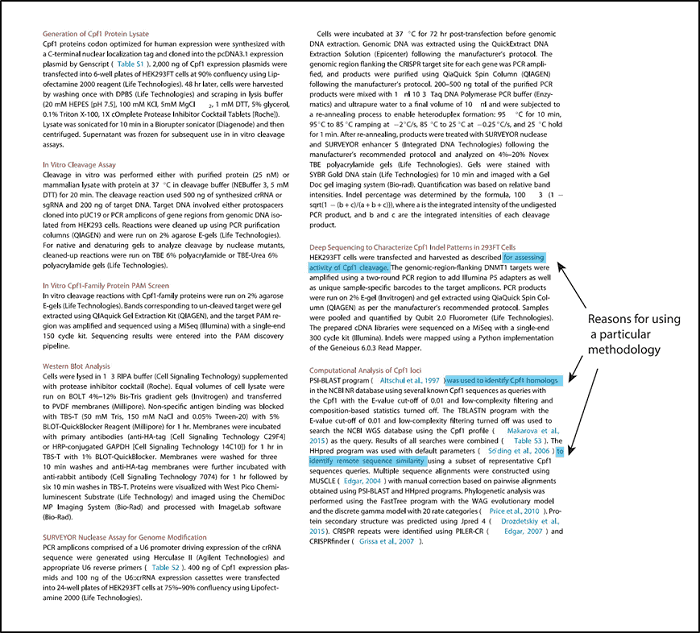以下内容首发于微信公众号:【埃米编辑SCI论文润色】。关注微信公众号,写作投稿更容易~如有论文润色需求,可以联系我们哦~
材料方法(Materials & Methods)的写作难度,在整篇论文中应该算是最好写的了。但实际情况是,很多论文在这块仍然存在不少问题。要想论文得到认可,方法部分必须让人一目了然又专业。接下来,跟着顶刊一起来学习吧。
1 Methods写作原则
麻省理工发布的期刊文章写作中指出:成功的Methods部分必须具备两项原则:
1) 提供选择方法的原因;
2) 允许读者通过复制来确认您的发现。
简单来说,写Methods部分的核心原则就是:让读者明白你做了什么?怎么做的,甚至能够按着你的描述来复现实验。几个要点:
1) 方法的精准性
方法描述必须精确到实验设计的关键要素,包括样本处理、设备型号、参数设置、以及分析工具与方法。任何可能影响实验可重复性的细节都应详尽呈现,避免主观解释和模糊术语,以确保同行学者能够完全再现实验。
2) 系统性与逻辑性
方法部分应严格按实验顺序或逻辑顺序组织,逐步推进,以保证步骤清晰且内在关系明确。每一操作应紧密衔接,以减少信息割裂,让读者能够顺畅地理解你的研究流程。
3) 一致性与标准化
术语、符号、度量单位、设备名等应始终保持统一,符合行业标准,以确保文本表达精确、连贯,避免因术语变动导致的误解。“常识”也要写清楚,不能假设读者都了解哦。
4) 相关性与简明性
确保方法描述与研究目的、结果分析相吻合,避免信息不对称或遗漏。简单明了的表达可以确保读者的阅读流畅性,也能让你的实验设计的核心更加突出。
5) 方法部分一般使用被动语态。
2 撰写Methods容易出现哪些问题呢
1) 操作过程不全:有些细节你觉得是“常识”没写,结果让人复现不了。所以,在撰写Methods的过程千万不要省略,以便读者可以获得相同或相似的结果。
2) 参数不说明:包括用到的数值、材料、软件版本这些细节没有说清楚,你需要将具体数值、型号一一交代清楚,尤其是机器和工具的细节。
3) 语句过于复杂:有时候为了显得专业,句子写得很复杂,其实简单直接的表达方式是最有效的。像很多顶刊文章的Methods部分,都是非常明确,不绕圈子的。
4) 重复率问题:在撰写论文时,即使是使用类似的方法,也尽量用自己的语言重新描述,避免增加文章的重复率。即使是自己以前发表的论文,也不能重复哦~
3 CNS文章材料方法拆解
案例拆解:来自Cell 期刊


图片来源:https://mitcommlab.mit.edu/be/commkit/journal-article-methods/
4 Materials & Methods句型模板
最后,部分句型模板供参考:
1) 描述材料和设备
● We utilized [specific equipment/model] (manufacturer, country) to conduct [specific procedure].
● [Sample/material] was prepared by [method] under [specific conditions].
● All chemicals/reagents were obtained from [supplier], with a purity of [purity level].
2) 详细描述实验步骤
● Each [sample/specimen] was [processed/prepared] by [method, e.g., ‘incubating’] at [temperature] for [duration].
● [Step/Procedure] was repeated [number of times] to ensure [purpose, e.g., consistency, accuracy].
● To [achieve specific goal], [procedure] was performed as follows: [describe step-by-step].
3) 数据收集和分析方法
● Data were collected using [instrument/software version] with parameters set at [specific values].
● Analysis was conducted using [statistical software/method] at a significance level of [p-value threshold].
● For statistical comparison, we applied [method, e.g., ‘ANOVA’, ‘t-test’], with adjustments for [variables, if applicable].
4) 提供实验依据或特殊条件
● To account for [variable or experimental condition], we modified [method] by [specific change].
● This method was selected due to its ability to [reason, e.g., ‘maximize accuracy in...’].
● Given [specific limitation or challenge], we implemented [additional step/alternative method].
5) 描述对照组和重复实验
●Control groups were established by [describe control setup], ensuring consistency across [variables].
●Each experiment was performed in triplicate to enhance reproducibility and statistical reliability.
●Replicates were conducted to minimize variation, with [number] independent trials for each condition.
6) 伦理与合规声明(如适用)
● All procedures involving human/animal subjects were approved by [institutional review board/ethics committee] under protocol number [number].
● Informed consent was obtained from all participants in accordance with [institutional guidelines].
总之,方法部分需要用清晰的语言、详细的步骤、合理的结构呈现出来,让别人能够复现。 希望通过这篇推文,你也能快速写出高质量的Materials & Methods部分。
扫描下方二维码,关注【埃米编辑SCI论文润色】微信公众号,获取更多SCI论文写作资料,回复“礼包”,免费领取100+写作投稿资料包和投稿问题30问。

参考资料:
[1]https://www.researchgate.net/publication/373507580_How_to_Write_the_Methods_Section_of_a_Research_Manuscript
[2]https://mitcommlab.mit.edu/be/commkit/journal-article-methods/